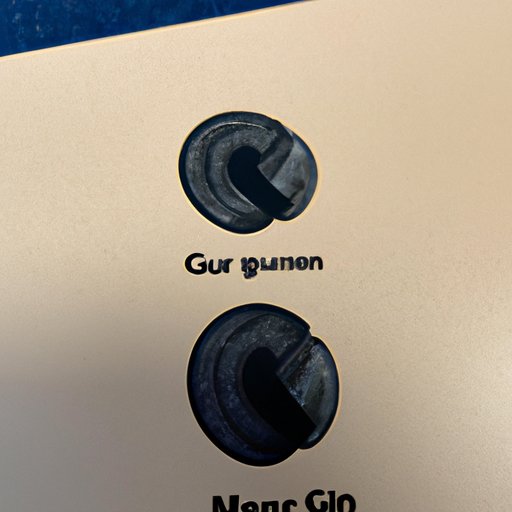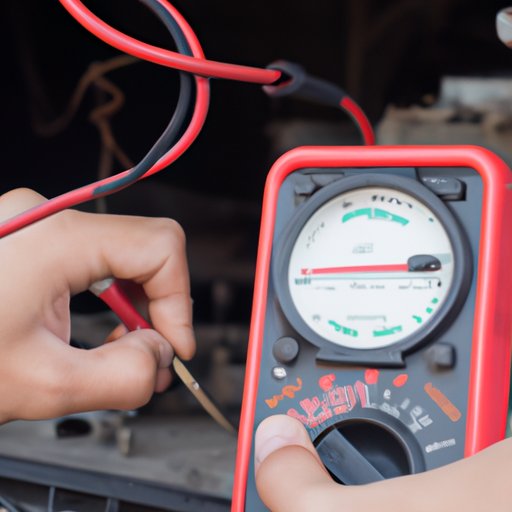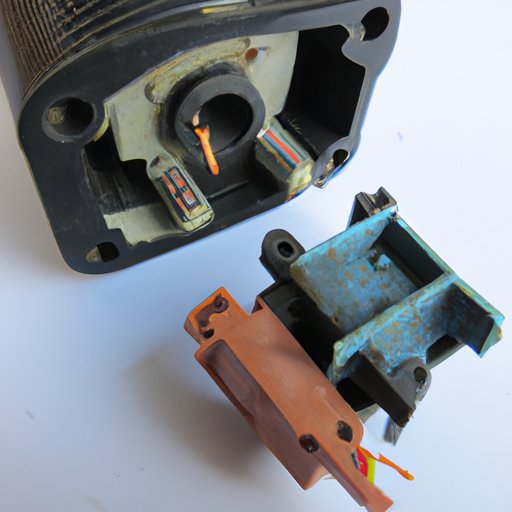Introduction
The starter is an essential component in any vehicle’s engine. It is responsible for turning the crankshaft and initiating the combustion process that allows the vehicle to move forward. Unfortunately, starters can become faulty over time due to wear and tear or other factors. Knowing how to check if your starter is bad can help you diagnose and fix the problem quickly and efficiently.
This article will provide a comprehensive guide on how to check if your starter is bad. We will cover the symptoms of a bad starter, what to do if you hear a noise, checking the battery voltage, testing the starter solenoid, inspecting the starter, having a professional check the starter, and using a multimeter to check for power at the starter.

Listen for Grinding or Clicking Noises
One of the first signs of a bad starter is the presence of grinding or clicking noises when you turn the key in the ignition. This is caused by the starter motor being unable to engage the flywheel, which prevents the engine from starting. If you hear this noise, it is likely that your starter needs to be replaced.
Symptoms of a Bad Starter
In addition to the grinding or clicking noises, there are several other symptoms of a bad starter:
- The engine won’t start when the key is turned
- There is a delay between turning the key and the engine starting
- The starter motor makes a whirring or buzzing sound
- The starter motor runs continuously
What to Do if You Hear a Noise
If you hear a grinding or clicking noise when you turn the key in the ignition, the first thing you should do is try to jump start the vehicle. This involves connecting jumper cables to the battery of another car and attempting to start the engine. If the engine starts, then the problem is most likely not with the starter but with the battery. If the engine does not start, then the problem is most likely with the starter.
Check Battery Voltage
Another way to check if your starter is bad is to check the battery voltage. A weak or dead battery can prevent the starter motor from engaging properly, so it is important to make sure that the battery has enough charge before attempting to diagnose any other problems.
Checking the Battery Voltage
To check the battery voltage, you will need to use a voltmeter. Connect the voltmeter to the battery terminals and note the reading. The optimal voltage for a fully charged battery is 12.6 volts. If the reading is lower than this, then the battery may need to be recharged or replaced.
Signs of Low Battery Voltage
In addition to checking the voltage, there are several other signs of a low battery voltage:
- The headlights are dimmer than usual
- The dome light is dimmer than usual
- The engine takes longer to start than usual
- The dashboard lights flicker or dim when the engine is running
Test the Starter Solenoid
The starter solenoid is the part of the starter motor that engages the flywheel. If the solenoid is faulty, then the engine will not start. To test the starter solenoid, you will need to jump the solenoid with a pair of jumper cables.
Jumping the Starter Solenoid
To jump the starter solenoid, you will need to connect one end of the jumper cable to the positive terminal of the battery and the other end to the solenoid. Then, connect the negative terminal of the battery to the starter motor. When you turn the key in the ignition, the solenoid should click and the engine should start.
Tools Needed for this Test
In order to perform this test, you will need a pair of jumper cables, a voltmeter, and a wrench or socket set.
Inspect the Starter
Once you have tested the starter solenoid, the next step is to inspect the starter itself for signs of wear and damage. A faulty starter motor can cause the engine to misfire or fail to start, so it is important to make sure that the starter is in good condition.
Signs of Wear and Damage
When inspecting the starter, look for signs of corrosion, dirt, or debris. Also, check the brushes inside the starter motor for signs of wear or damage. If the brushes are worn down or damaged, they will need to be replaced.
What to Look For
In addition to checking the brushes, look for any signs of electrical arcing or burning. This can indicate a short circuit or other issue with the starter motor. If you find any signs of arcing or burning, then the starter motor will need to be replaced.
Have a Professional Check the Starter
If you are still unsure whether or not the starter is bad, then it is best to have a professional check the starter. A professional technician will have the necessary tools and experience to diagnose and fix any issues with the starter motor.
Advantages of Having a Professional Check the Starter
Having a professional check the starter motor offers several advantages:
- The technician will be able to accurately diagnose the issue and recommend the best course of action.
- The technician will be able to identify any underlying issues that could be causing the problem.
- The technician will be able to repair or replace any faulty components.
Tests Performed by a Professional
A professional technician will perform several tests to diagnose any issues with the starter motor. These tests include checking the battery voltage, testing the starter solenoid, and inspecting the starter for signs of wear and damage.

Use a Multimeter to Check for Power at the Starter
Another way to check if your starter is bad is to use a multimeter to check for power at the starter. This test will help you determine whether or not the starter is receiving power from the battery.
Steps for Testing the Starter with a Multimeter
To test the starter with a multimeter, follow these steps:
- Disconnect the negative battery cable.
- Set the multimeter to measure DC voltage.
- Connect the red lead of the multimeter to the positive terminal of the starter.
- Connect the black lead of the multimeter to the negative terminal of the starter.
- Turn the key in the ignition and observe the reading on the multimeter.
If the multimeter reads 12 volts or more, then the starter is receiving power from the battery and is not the source of the problem. If the multimeter reads less than 12 volts, then the starter is not receiving power and needs to be replaced.
What to Look Out For
When performing this test, be sure to follow all safety precautions and wear protective gear. Also, be sure to disconnect the negative battery cable before beginning the test to avoid any potential risks.
Conclusion
Knowing how to check if your starter is bad can save you a lot of time and hassle. In this article, we have provided a comprehensive guide on how to diagnose and fix any issues with the starter motor. We covered the symptoms of a bad starter, what to do if you hear a noise, checking the battery voltage, testing the starter solenoid, inspecting the starter, having a professional check the starter, and using a multimeter to check for power at the starter.
Summary of Steps Taken
To summarize, the steps for checking if your starter is bad are as follows:
- Listen for grinding or clicking noises.
- Check the battery voltage.
- Test the starter solenoid.
- Inspect the starter for signs of wear and damage.
- Have a professional check the starter.
- Use a multimeter to check for power at the starter.
Final Thoughts
Having a faulty starter can be a major inconvenience, but knowing how to check if your starter is bad can help you diagnose and fix the problem quickly and efficiently. If you suspect that your starter is bad, following the steps outlined in this article can help you determine the source of the problem and take the necessary steps to fix it.
(Note: Is this article not meeting your expectations? Do you have knowledge or insights to share? Unlock new opportunities and expand your reach by joining our authors team. Click Registration to join us and share your expertise with our readers.)
